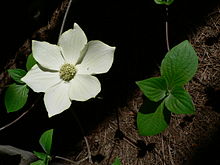Cornus nuttallii
| Pacific dogwood | |
|---|---|
 |
|
| Scientific classification | |
| Kingdom: | Plantae |
| (unranked): | Angiosperms |
| (unranked): | Eudicots |
| (unranked): | Asterids |
| Order: | Cornales |
| Family: | Cornaceae |
| Genus: | Cornus |
| Subgenus: | Cynoxylon |
| Species: | C. nuttallii |
| Binomial name | |
|
Cornus nuttallii Audubon ex Torr. & A.Gray |
|
 |
|
| Natural range | |
| Synonyms | |
|
Benthamidia nuttallii (Audubon ex Torr. & A.Gray) Moldenke |
|
Benthamidia nuttallii (Audubon ex Torr. & A.Gray) Moldenke
Cornus nuttallii (Pacific dogwood,mountain dogwood,Western dogwood, or California dogwood) is a species of dogwood native to western North America from the lowlands of southern British Columbia to the mountains of southern California, with an inland population in central Idaho. Cultivated examples are found as far north as Haida Gwaii. It is a small to medium-sized deciduous tree, reaching 10–25 m tall.
The leaves are opposite, simple, oval, 8–12 cm long, and 5–8 cm broad. The flowers are individually small and inconspicuous, 2–3 mm across, produced in a dense, rounded, greenish-white flowerhead 2 cm diameter; the 4-8 large white "petals" are actually bracts, each bract 4–7 cm long and broad. The fruit is a compound pink-red berry about 3 cm diameter, containing 50-100 small seeds; it is edible, though not very palatable.
Like the related Cornus florida, it is very susceptible to dogwood anthracnose, a disease caused by the fungus Discula destructiva. This has killed many of the larger plants in the wild and also restricted its use as an ornamental tree.
Cornus nuttallii is named after Thomas Nuttall, an English botanist and zoologist who worked in North America in the nineteenth century.
Some Plateau Indian tribes used the bark as a laxative and emetic.
It is the provincial flower of British Columbia in 1956. It was once protected by law in the province (in an act which also protected Rhododendron macrophyllum and Trillium ovatum), but this was repealed in 2002.
...
Wikipedia
